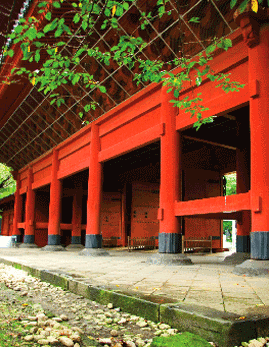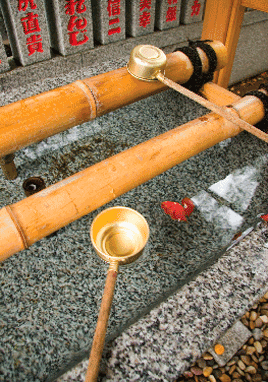Have you ever wondered about the steps and symbols involved in worshiping at a Shinto Shrine or Jinjya?
Shinto means “the way of gods.” Shintoism is not based on the belief of one god, but 800 gods, so each shrine has different gods to worship. Shintoism is deeply rooted in Japanese life, and is a general term for Japanese people to worship all aspects of nature.
The entrance to most Jinjya is marked by Torii gates. Inside the Torii, shi-shi can be found on either side of the entrance. Shi-shi (also called Koma-inu) are guardian lion-dogs or foxes, and are there to scare off demons and to keep good spirits in.
Inside you will see the purification fountain. This is for washing your hands and mouth to purify your body and mind before praying. Here is the proper way to wash:
1) Fill ladle with fresh water with your right hand and wash your left hand.
2) Next, wash your right hand.
3) Make a cup with your hand and rinse your mouth. (Spit the water beside the fountain. However, do not make a noise or gargle.)
4) Wash your left hand again.
5) Fill ladle with fresh water and stand it upright to wash the ladle’s handle.
6) Put the ladle back. (Invert the cup part).
Now you can go to the main hall. At the main hall:
1) Throw a coin in to the offering box. (We usually put in a ¥5 coin because it is our lucky coin and is a symbol of “relationships.”)
2) Bow deeply twice.
3) Clap your hands twice to call the attention of the gods.
4) Bow deeply once again and pray.
If there is some type of gong or bells, you should ring them after you throw in your coin. This is also done to get the attention of the kami (gods).
In Jinjya, you may see an area filled with wooden plaques covered in writing. These are ema, and are a place for people to write their wishes for good health, successful businesses, love, wealth, etc…
You will also see many white papers tied on stands or trees. These are Omikuji (Japanese fortunes). You pay a small fee (usually ¥100) at the counter and then draw a stick from the box. Present the stick to the attendant (mi-ko), and you will be given a piece of paper with your fortune.
Daikichi = a lot of luck
Chuukichi = some luck
Shoukichi = little luck
Kyou = regular bad luck
Daikyou = a lot of bad luck
However, even if you get “Daikyou”, don’t worry. You can tie (mu-su-bu) the Omikuji on the stand. The word “mu-su-bu” has many meanings. One is “stop” or “end” and the other is “tie up” or “fruition”. So, if you get Daikichi, it’s still good idea to tie it on the stand, so your good luck will come to fruition!


